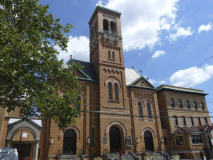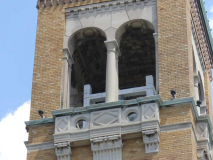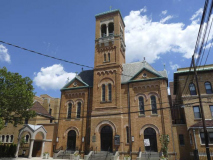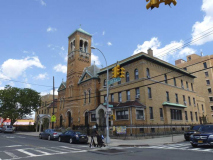
MANY New Yorkers cite 1993’s A Bronx Tale, written and acted in by Chazz Palminteri and produced and acted in by Robert De Niro, as their favorite movie. Though A Bronx Tale was set in the Arthur Avenue region in the Bronx, many of its exteriors were filmed here on 30th Avenue in the 40s streets in Astoria, using vintage buses from the NYC Transit Museum (De Niro’s character was a bus driver). De Niro and Palminteri felt that because so many older buildings were preserved along this stretch, which is less crowded than Arthur Avenue, it would be a better place to film. Palminteri’s mobster, Sonny’s club “Chez Bippy” was filmed at this corner, 30th Avenue and 44th Street.
East of 41st Street, 30th Avenue enters the Mathews Zone: several blocks of apartment buildings constructed with yellow bricks from the kilns of Balthazar Kreischer in the far south end of Staten Island and developed by Gustave X. Mathews beginning in 1915.
The Mathews Model Flats were built by speculative developer Gustave X. Mathews and designed by Louis Allmendinger in the early part of the 20th Century. Considered to be some of the most innovative housing in the city, these “new law” tenements were designed with more space and better sanitation than their overcrowded 19th Century counterparts. By making use of generous lot sizes, introducing wide air shafts to provide improved air circulation and light quality, including bathrooms in each unit, and limiting the number of apartments per floor, Mathews established a new housing paradigm that was a welcome departure from the congested tenements of the Lower East Side. The three story apartment buildings were simple, sturdy, and relatively cheap to construct, and therefore became the standard for subsequent tenement house construction. Exhibited at the 1915 Panama Pacific Fair in San Francisco, the Mathews Model Flats were heralded as an exceptional achievement. Municipal Art Society
One of Queens’ most impressive brick churches, St. Joseph’s R.C. Church, 30th Avenue between 43rd and 44th Streets. The church was organized in 1877 when there was a large amount of German Catholics in the region (the Steinways had set up their piano manufacturing plant in Astoria that decade), with the first wooden structure erected in 1880, and the current building with its massive campanile (bell tower) in 1906. Catholic churches seem to build the equivalents of small towns for their parishes, and the church is surrounded by a school rectory and convent.
As always, “comment…as you see fit.” I earn a small payment when you click on any ad on the site. Take a look at the new JOBS link in the red toolbar at the top of the page on the desktop version, as I also get a small payment when you view a job via that link.
1/16/25






6 comments
I recall my grandmother, who was a young girl when the first Matthews Flats were constructed, telling me that the early ones were “cold water” flats. That would mean they had running water, but it was only cold water, and that there was likely not central heat. I have not seen any reference to this in articles about the Matthews Flats and wonder if anyone can offer comment.
Dialogue to the effect of:
“If your father can’t pay the rent, go tell Mickey Mantle, see what he says…Nobody cares, kid…”
Now, is that great dialogue, or what?
But wait, therealguyfaux, here’s more:
https://www.bing.com/videos/riverview/relatedvideo?q=you%20tube?%20Bronx%20tale/%20%22mickey%20Mantle%20makes%20100%20thousand%20a%20year…%22&mid=EAC9D924036F9A4C33F5EAC9D924036F9A4C33F5&ajaxhist=0
The new “Goosebumps: The Vanishing” TV show is set in Gravesend, Brooklyn yet is filmed in Ridgewood, Astoria and Fort Totten in Queens. And very obviously in Astoria Park (with the Hell Gate and Triborough Bridges clearly in the background). Makes one wonder why they just didn’t set the show in Queens, unless they wanted to use “Gravesend” as a creepy setting.
It’s common for TV shows and movies to filmed somewhere else despite saying where they are due to costs, so this one isn’t something new.
Sometimes, the reverse happens. A show that is supposed to be somewhere else is filmed in New York. A great example of this was the long-running “Madam Secretary”, the plot of which took place in Washington, DC with occasional instances around the world. Most of the outdoor scenes were filed in various locations around New York City. A knowledgeable viewer, with a keen eye, can spot them on almost every show.